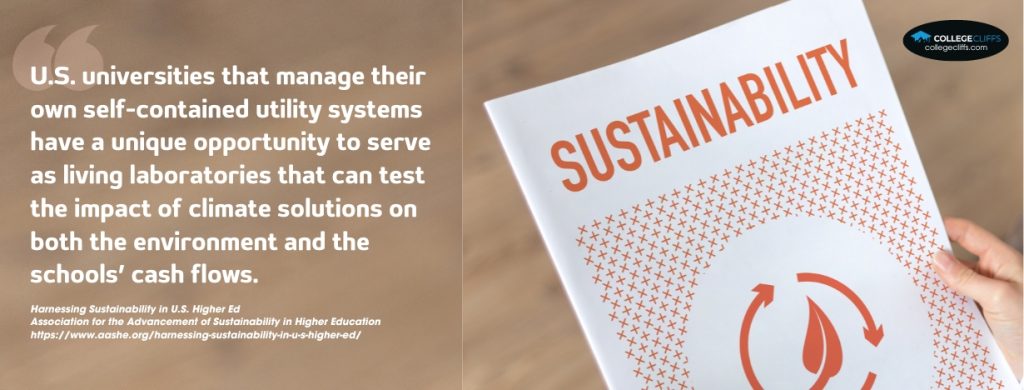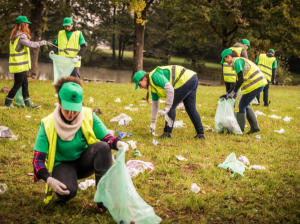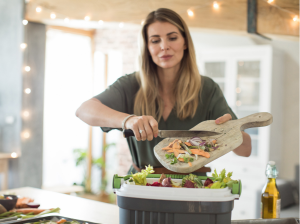10 Useful Tips to Live Sustainably as a College Student
Find your perfect college degree
The United States is one of the most populated among developed countries, and its growth is not likely to slow down any time soon. With the country’s increasing population, more and more natural resources will be used.
This surge in resource consumption poses significant challenges to environmental sustainability, prompting the need for innovative solutions and responsible practices.

You don’t have to become a professional environmentalist to contribute to the collective effort in mitigating these challenges. Your small, everyday actions can cumulatively make an impact on the environment.
As a college student, here are a few useful tips to help you live more sustainably and reduce your ecological footprint:
How To Live Sustainably in College
Conserve as much energy as much (and as often) as you possibly can.

College is very demanding. You’ll have coursework on top of coursework, which may lead to continuous all-nighters. You’ll spend most of your days in your room, especially during exam weeks, and use more energy than you might realize.
One of the best ways to conserve energy as you spend more time in your dorm room is switching to energy-efficient bulbs such as compact fluorescent lamps (CFLs) or light-emitting diodes (LEDs). These light sources are known to consume less energy and, at the same time, have longer life spans.
So, if you think about it, you’re saving energy and helping Mother Earth and saving yourself money and multiple trips to the hardware store to purchase new light bulbs.
You’ll not use your light source 24 hours a day, that’s for sure. On top of switching to energy-efficient bulbs, you should also practice energy-conscious habits. Develop a routine of turning off lights, fans, and any electronic device when leaving your dorm room or when you’re not using them. Consider unplugging chargers to mitigate “phantom” energy consumption.
Another way to save energy is to be mindful of your settings—of your laptops, PCs, phones, and other e-devices. Always turn on the “energy-saving” option on all your devices. Doing this prolongs the battery life, thereby reducing electronic waste. Do not fall asleep watching a movie from your phone, either!
Another pro tip is to reduce heating and cooling needs by strategically adjusting thermostats to maintain moderate temperatures—lowering the heat in winter and raising the cooling in summer can result in significant energy savings.
Fortify against drafts by conducting a thorough check to ensure windows and doors are effectively sealed, preventing unnecessary heat loss in winter and enhancing cooling efficiency during the summer months.
Use sustainable transportation.
Some students are studying in commuter schools, meaning they live off campus and must travel back and forth to attend classes. As a commuter student—whether driving your car, using public transportation, or booking an Uber or Lyft—you will always have to pay for your transportation.
While commuting introduces additional challenges to sustainable living, there are still several ways to minimize environmental impact and make eco-friendly choices.
Choose sustainable commuting options, including public transportation like buses and trains, that reduce the carbon footprint associated with individual commuting. You can also consider carpooling with classmates who live nearby or share similar routes, as it not only saves fuel but also contributes to easing traffic congestion.
Another option, if you live nearby, is to embrace alternative transportation methods like biking or walking. These methods are eco-friendly and promote physical activity and personal well-being. But we’re not suggesting these sustainable approaches if you live miles from your campus.
If you must drive, you should choose a fuel-efficient vehicle and maintain it regularly with oil changes and tire checks. You should also practice efficient driving by planning trips to combine errands. Always aim to reduce the number of separate driving occasions and save time and fuel.
Buy local.

Gone are the days when people believed local farmers’ markets and products were significantly more expensive than products from big chain companies. The tide is turning, and customers are now benefiting from reduced pricing for locally created goods because of a more crowded and, consequently, more competitive marketplace of independent merchants.
Purchasing locally has been very popular lately. It explains the popularity of 100-mile meals and farmers’ markets.
Some students may wonder how buying local food helps with the environment.
For one, buying local food reduces food miles and makes goods produced in your local community more accessible. Local businesses operate in their communities, making them easier to access and maintain.
Most of the time, you can easily walk or bike to local markets. With shipping facilities, packing facilities, or refrigeration out of the equation, you reduce fuel consumption and air pollution.
Buying locally also protects local lands and wildlife by supporting local farmers and producers, preventing them from being sold to developers or big business producers. This will also support the local workforce, ensuring that local businesses remain in place and contribute to reducing carbon footprint.
Aside from environmental benefits, buying local produce will also benefit your health. Locally sourced produce is often fresher, as it spends less time in transit. This can result in higher nutrient retention than fruits and vegetables traveling long distances.
Avoid water waste.
There are several ways to save water, whether on campus, in your room, or anywhere you might be. One of the easiest ways to avoid water waste is to adopt mindful water usage practices in various areas of your daily routine. When doing laundry or washing dishes, ensure you run full loads and use the shortest machine cycles, maximizing efficiency.
Additionally, consider taking shorter showers, as the average 10-minute shower uses around 100 liters of water. Even cutting your shower time in half can lead to substantial water savings over time.
Another practical approach is to use refillable water bottles instead of buying plastic bottles daily. It reduces plastic waste and promotes sustainable water consumption. Take advantage of campus complimentary water bottle refilling stations when it’s safe to do so.
Be proactive about leaks or running water and promptly report such issues to the appropriate authorities. A dripping faucet or leaky toilet can result in significant water wastage over time.
If you have outdoor spaces, consider watering during the evening or early morning hours to minimize evaporation and ensure optimal absorption by the grass.
Support/join sustainability initiatives.

A lot of students may not realize this, but they can make a positive impact on the world. One of the biggest examples of how students can create a meaningful impact is Teresa Cheng, a former USC student who won multiple campaigns to advance workers’ rights globally.
College may leave you with a hectic schedule. And often, you’ll not have free time for extracurricular activities. But if you have free time, you can join green initiatives prompted by your college, university, or your community.
Participating in local environmental clubs, organizing tree-planting events, and engaging in community clean-up projects can significantly contribute to campus-wide climate change activism. Education about climate change and its impacts can also inspire action.
Suppose you don’t have the time to engage in university- and community-wide sustainable initiatives due to the college course load. In that case, you can use your social media to share content highlighting campus initiatives and raising awareness.
On the other hand, if your goal is to change the word, here are a few helpful tips on how you can begin:
- Research sustainability practices, successful initiatives, and potential challenges to understand environmental issues relevant to your campus and region.
- Create a team with diverse skills, perspectives, and passions. This will give you the necessary support, creativity, and human resources to implement and sustain environmental initiatives effectively.
- Create a comprehensive strategy outlining goals, action plans, and timelines, and collaborate with various departments, student organizations, and external partners for a unified approach to sustainability initiatives.
- Engage all stakeholders in sustainability efforts, foster collaboration, and learn from peers to drive policy changes and financial support.
- Set ambitious, long-term objectives aligned with global sustainability targets for individual projects and initiatives, inspiring others to take part in the collective pursuit of a sustainable future.
Be thrifty.
The key to thrifting includes prioritizing what matters to you as a spender. One of the most effective ways to be smart in your spending is to use alternative shopping sources.
Thrift shopping is a sustainable approach to fashion, reducing textile waste, resource conservation, and carbon footprint. By purchasing second-hand items, you prolong the life of products, preventing the need for new manufacturing and reducing raw material, energy, and water consumption. This cycle of resource conservation benefits both the environment and future generations.
Thrift shopping also minimizes the carbon footprint associated with manufacturing and shipping, reducing greenhouse gas emissions. It strengthens community bonds, supporting local businesses and fostering a sense of community.
Additionally, thrift shopping promotes ethical consumption, as it is not associated with exploitative supply chains, promoting fair treatment for workers worldwide.
Reuse and recycle.

Ah! The good old-fashioned “reuse and recycle” method. It’s not just a philosophy but a call to action, a series of small yet impactful choices that collectively shape a sustainable lifestyle. Embracing this ethos extends beyond a conceptual shift; it’s about integrating mindful practices into our daily routines.
Plastic bags are a nonrenewable resource, producing greenhouse gasses and wasting resources. And because they are difficult to break down, they harm the ocean and natural ecosystems. Reusable bags from renewable materials like jute, cotton, or bamboo reduce litter and contribute to ecosystem health.
They also minimize waste by reducing the need for single-use plastic bags, which can end up in landfills. Reusable grocery bags, like RPET, made from plastic bottles or cotton, can be recycled, breaking down and reducing landfill overflow.
Another effective way to reuse and recycle is to use reusable containers for food storage. Purchasing a set of sturdy, high-quality containers is a simple move with big implications. For food storage, choose materials like glass or stainless steel, which are safer and better for the environment.
You can also start a backyard composting bin for your yard clippings and kitchen scraps and turn them into nutrient-rich compost. This method will reduce the waste in landfills and serve as a valuable resource for your garden.
Practice responsible printing.
The rapid loss of forests, primarily for producing paper goods, is highly concerning to the ecosystem. As we know it, trees are essential to life because they produce oxygen and remove CO2 from the atmosphere.
Papers are so common that we barely realize how much energy and raw materials it took to manufacture and distribute them. And that’s why many of us don’t know how to use paper wisely. According to Environment America, paper goods are thought to make up nearly a quarter of garbage in the US.
Understandably, college includes a significant amount of paper-based activities, from note-taking to printing assignments—and it’s easy to overlook how these practices impact the environment.
As we move forward to a time that is characterized by environmental awareness, it pays to reevaluate how much paper we use and, ultimately, switch to more environmentally friendly options.
This is why a lot of sustainability-focused schools are going paperless.
To minimize resource usage, optimize printer settings, print only what’s necessary, explore sustainable paper options, use electronic annotation tools, share documents digitally, encourage digital submissions, and consider reusing and recycling paper. Choose double-sided printing, draft or eco-friendly modes, and grayscale for better results.
Other ways you can save the trees and minimize use of paper goods include:
- Use reusable cloth napkins to wipe countertops instead of paper towels.
- Getting a coffee maker that doesn’t use a paper filter.
- Use a board or laminated paper.
- Reading news online instead of buying newspapers.
Give meatless Mondays a try.

The idea behind Meatless Monday is to cut out meat one day a week and gradually eat more plant-based meals. Sid Lerner launched the program in 2003 after discovering that Mondays are the days when individuals are most receptive to making positive changes.
The consequences of the meat industry on the environment are immense and catastrophic. The Environmental Protection Agency (EPA) says agricultural operations significantly impact water quality, with runoff being the leading cause of water quality impacts.
Nutrients, pesticides, and herbicides from agricultural activities can cause soil erosion, nutrient loss, and bacteria in local streams, rivers, and groundwater. These pollutants can also enter groundwater, affecting drinking water sources and posing health risks to human health.
Adopting a meatless diet, even at least once a week, can contribute to environmental sustainability, even though they might not be able to address all environmental issues fully. You help reduce greenhouse gas emissions, conserve natural resources, reduce energy consumption, reduce deforestation, conserve water, mitigate pollution, and protect biodiversity.
It also reduces the environmental strain associated with animal agriculture, reduces energy consumption, and supports diverse ecosystems.
Take a sustainability class.
Several countries, including the United States, are experiencing a rise in pollution. Large cities in the State can no longer see the stars at night due to air and light pollution. As a result, several colleges and universities in the country have integrated sustainability education into their curricula.
Students taking sustainability courses will develop a deep understanding of the complex interrelationships between human activity and the environment. You’ll also be able to study the social dynamics that either exacerbate or alleviate environmental problems. Upon completing the course, you’ll know how to address real-world challenges.
Furthermore, the emphasis on sustainability education aligns with the rising need for professionals who possess a thorough awareness of social responsibility and environmental stewardship.
Companies in various sectors are looking for people who can support sustainable practices in any way, such as developing environmentally friendly technologies, putting corporate social responsibility programs into action, or creating laws dealing with social and environmental issues.
Frequently Asked Questions
Are there campus initiatives or clubs focused on sustainability?
Colleges often have sustainability initiatives, clubs, or organizations that offer opportunities for eco-friendly projects, idea sharing, and raising campus awareness about sustainable living.
Where can I find resources and support for sustainable living on campus?
Visit your college’s sustainability office or environmental studies department for resources, guidance, and information on sustainable living, often with dedicated websites or staff to assist students in adopting environmentally friendly practices.
Are there sustainable housing options on campus?
Some colleges may provide green housing options with energy-efficient appliances, water-saving fixtures, and eco-friendly materials. Consult the housing office at your university for information on their environmentally friendly housing options.
Additional Resources:

